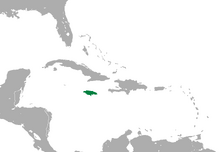|
Out of Many, One People | |||||
| Capital | Kingston | ||||
| Largest city | Kingston | ||||
| Other cities | Montego Bay, Mandeville, Spanish Town | ||||
| Language official |
English | ||||
| others | Spanish | ||||
| Demonym | Jamaican | ||||
| Governor | Andrew Holness | ||||
| President of the Senate | |||||
| Area | 4,244 mi² | ||||
| Population | 2,845,000 (2010 est.) | ||||
| Independence | from United Kingdom | ||||
| declared | 6 August 1962 | ||||
| Currency | East Caribbean Dollar | ||||
Jamaica is the largest state of the East Caribbean Federation. As a founding member of the Federation, the formerly independent nation had been a Commonwealth member ruled by a Governor General and the British Monarch. Since Doomsday, the nation has broken its ties with the Commonwealth and now elects its leaders directly after the pattern of the United States. As a member of the ECF, the title of the leader was changed to simply 'governor,' and the title of prime minister has been changed to "president of the Senate" and is chosen from that body.
In the midst of a decline in 1983, the nation emerged strong with the creation of the ECF. By far the largest state, it has the largest armed forces and civilian police force, making it essential in the defense of the Federation against nearby Cuba and the Dominican Republic. It's former dependence upon the United States also made it a natural ally to the United States Atlantic Remnant from its very beginning.
History
Pre-Doomsday
Settled sometime before 1000 BC by Ararak and Taino peoples from South America, the island was called "Xaymaca,' meaning "Land of wood and water." First contact with European explorers was with Christopher Columbus in 1494. The 200 or so villages were easily subjugated due to their peaceful nature. However, there was still an indignant population in 1655 when the English took possession on the island. The English returned the original name - to the best of their ability phonetically - coming up with "Jamaica."
The Spanish had used African slaves as did the English after them, freeing them to escape to the mountainous interior of the island to live among the Taino population. Escaped slaves had often sought refuge in the mountains, so the population of African-Jamaicans easily surpassed the white population within decades of the English settlements beginning. Nevertheless, the plantations held a good many African slaves for almost two centuries before all Caribbean slaves were freed in 1838. At that point those of African descent outnumbered the white population almost 20 to 1.
Throughout the latter part of the 19th century and first half of the 20th Jamaica grew prosperous under British rule, but finally became an independent nation in the Commonwealth in 1962. Prosperity that had started as a result of the sugar industry (with slaves and indentured servants) had given way to mining of local bauxite for the aluminum industry. Also, as a tropical island the tourism trade flourished in the post-war period. Nevertheless, prosperity was not shared equally as a poor class arose in the cities. This inequity led to the rise of the People's National Party which came to power in 1972. Implementing progressive social programs, the PNP was unable to improve the financial situation among the poor, but rather produced a larger portion of the population in that category. By 1983 the gross national product had fallen 75% below the levels when the PNP came to power. The nation was on the brink of bankruptcy and the government had begun to reach out to its trading partners - primarily the United States and the United Kingdom - for economic aid.
Doomsday
Consequent to the economic downturn, the nuclear exchange of the week of September 25, 1983, came at what seemed to be a really bad time for the nation. On that evening, at around 7:45 pm local time, the satellite news feed from both the United States and the United Kingdom cut began to announce confirmed launch of nuclear weapons from the Soviet Union. Governor-General Florizel Augustus Glasspole came on the air at 8:00 pm urging calm, but at the same time issuing a state of high alert for the military and civil authorities. Prime Minister Edward Seaga convened an emergency session of parliament to determine the next step in international relations due to what appeared to be the onset of World War 3. By the time the two houses gathered on the morning of September 26th, all contact with Washington and London had been lost.
On confirmation of massive attacks to mainland North America, Glasspole contacted US Ambassador William Hewitt at the American embassy. The former head of John Deere, Hewitt had been appointed by Ronald Reagan in 1981. He was now the senior officer representing the office of the president and would be responsible for the safety of the small American presence in Jamaica. By treaty agreement, Jamaica became a safe harbor for any US ships and planes that had to land there. Because of the high crime rate in the cities anyway, curfews were declared until further notice for all residents of the island. Only official military or security forces were to be out after dark.
After Doomsday
B November 1983, most of the American military stationed throughout the Caribbean had made its way to Jamaica. They helped bolster the Jamaican military in keeping order throughout the island for a time being.
Government
Economy
See also
| |||||||||||
| ||||||||||||||||||||||


